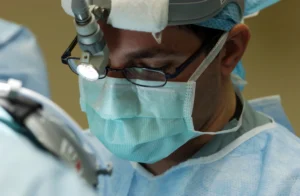Introduction
 In the medical device industry, the balance between functionality, usability, and cost-effectiveness is critical. Cooper Surgical, a prominent player in the medial field, approached Vaupell with a unique challenge: to design a complex yet user-friendly Port Closure System. The device required precision in its assembly, including welded parts, suture paths, and a spring-loaded plunger, all while ensuring that the user’s gloved hands would not be compromised. This case study explores how Vaupell’s expertise in design and molding led to the successful development of an innovative solution that met all design, usability, and budgetary requirements.
In the medical device industry, the balance between functionality, usability, and cost-effectiveness is critical. Cooper Surgical, a prominent player in the medial field, approached Vaupell with a unique challenge: to design a complex yet user-friendly Port Closure System. The device required precision in its assembly, including welded parts, suture paths, and a spring-loaded plunger, all while ensuring that the user’s gloved hands would not be compromised. This case study explores how Vaupell’s expertise in design and molding led to the successful development of an innovative solution that met all design, usability, and budgetary requirements.
The Challenge
The primary challenge presented by Cooper Surgical was multifaceted. The Port Closure System needed to be an intricate assembly with specific features:
- Complex Design Requirements: The device had to incorporate welded parts, defined suture paths, and a spring-loaded plunger. These components needed to function seamlessly together while being user-centric, and precise.
- User Safety and Ergonomics: One of the critical considerations was ensuring that the device did not compromise the user’s gloved hands. In a sterile surgical environment, maintaining the integrity of gloves is essential to prevent contamination and ensure safety.
- Cost Constraints: The solution had to be economically viable. The initial design indicated that multiple molded components were necessary to meet the technical criteria. However, the larger size of the product requiring an additional component led to an unexpected increase in costs. The extra part also made the product susceptible to issues during deployment.
The Solution
Vaupell approached this challenge with a comprehensive and innovative design strategy. Leveraging our extensive experience in design and molding, we focused on developing a solution that not only met all technical and user requirements but also adhered to the budget constraints.
- Refined Design and Molding Expertise: The initial design phase highlighted the need for multiple molded components. However, our team identified that the additional part required in the larger size was causing cost overruns and potential reliability issues. We meticulously analyzed the design and explored alternatives that could streamline the assembly process while maintaining the device’s functionality.
- Ergonomic Considerations: A significant aspect of our solution was ensuring the device’s ergonomics. We prioritized a design that would be easy to handle, even with gloved hands. Our engineers developed a molded, ergonomic solution that allowed for intuitive operation, minimizing the risk of compromising the user’s gloves during use.
- Cost Efficiency: By optimizing the design and eliminating the need for the extra component, we successfully brought the project back within the projected cost targets. This not only made the product more economical, but also enhanced its overall reliability by reducing the complexity of the assembly.
Outcome and Impact
The result was a highly functional and user-friendly Port Closure System that met all of Cooper Surgical’s requirements. Our refined design and molding process ensured that the final product was not only cost-effective but also reliable and safe for use in surgical environments.
The successful development of this device highlights Vaupell’s capability to tackle complex design challenges and deliver innovative solutions that meet stringent criteria. Our collaboration with Cooper Surgical exemplifies how we can provide tailored solutions that enhance the usability and functionality of medical devices while keeping costs under control.
Conclusion
This case study illustrates Vaupell’s commitment to excellence in ideation and design. Our ability to adapt and innovate in the face of challenges enables us to provide our clients with solutions that meet their unique needs. The Port Closure System for Cooper Surgical stands as a testament to our expertise and dedication to delivering high-quality, user-centric products in the medical device industry.
